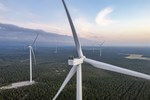Major new renewables report sheds light on the financial implications of a future powered by wind
And the pressure is far from off: offshore wind capacity needs to grow more than seven-fold by 2050 if the UK is to meet its net-zero targets, according to the Committee on Climate Change (CCC). As the first wind turbines reach the end of their lives, a further challenge is emerging, too: how can the sector reduce or eliminate waste from its operations?
To help answer these questions, ORE Catapult has launched a new joint industry programme– Circular Economy for the Wind Sector (CEWS). Its aim is to create a framework for decommissioning while exploring alternatives that can minimise the disposal of valuable materials and extend the life of offshore wind farms.
The most recent analysis conducted by CEWS produced some interesting findings on the financial implications of different decommissioning scenarios[1]. Our full paper can be found here, but the key conclusions are:
The most cost-effective strategy will be partial repowering, which involves installing larger turbines at an old site. This option offers a maximum return to developers of £221 million, extending the farm’s lifespan by 25 years and its electricity generation by more than 34,000 GWh (equivalent to the annual electricity consumption of almost 10 million homes).
This option needs to be factored into the site’s leasing plan from the start, however, as it requires developers to either install bigger foundations (in anticipation of larger turbines being installed at a future date) or initiate an inspection plan to assess the monopile’s structural ability to support a higher-rated turbine. Our analysis assumed that there would be no significant additional costs for foundation strengthening to support the turbine upgrade.
Full repowering offers a lower return to the developer of £105 million. The reduced return is because full repowering requires more than just replacing turbines (as in partial repowering); it also involves replacing infrastructure like foundations and cables.
Life extension is different from repowering. It does not involve replacing any major assets (turbines, cables or foundations); they remain in situ but are subject to minor repairs and corrective maintenance. This approach delivers a net present value of £148 million with the lowest investment cost of all scenarios studied. It also preserves the site’s annual electricity production for an additional ten years. If this is increased to 15 years, the net present value would reach £218 million.
Fully decommissioning a site, by contrast, would see a negative return of net present value between £22 million to £55 million. Removing the farm’s foundations, turbines and cables does not generate any future revenue, as well as being a costly process with the potential for delays.
The major issue surrounding this forward planning, is a lack of experience in carrying out decommissioning of offshore wind farms simply because the sector is so new. All new sectors experience something similar when growth has been exponential, and research is rightly focused on developing productivity.
In the future, developers will have to consider the options for decommissioning in more detail during the design phase of offshore wind farms to be able to plan ahead and make optimal adjustments for cost savings. At the moment, end-of-life strategies are not fully formed until the project comes to an end, and there is very limited regulatory support to guide wind farm developers.
The costs of different scenarios also need to be weighed against their environmental impacts. Our report found that life extension offers the lightest carbon footprint at 63 tCO2e per annum. Full repowering created the highest emissions of 2,707 tCO2e per annum due to a heavier footprint from vessel use. In comparison, partial repowering results in 1,417 tCO2e, full removal 1,330 tCO2e and partial removal 867 tCO2e.
It is vital these conversations are had now, and quickly, with key stakeholders and the UK Government to ensure developers choose the best option. We need to define best practices from both an economic and an environmental point of view if we are to ensure the future sustainability of this vast and ever-growing industry. This will be the core activity of our new JIP over the next five years.
ORE Catapult and RenewableUK are holding a joint virtual conference, Circular Economy + Renewable Energy, on June 29th to explore questions of decommissioning and sustainability for the wind industry and sectors with shared challenges.
[1] The cost-benefit analysis of each scenario refers to a representative UK offshore wind farm of 35 turbines (6MW rating) that will reach the end of its 25-year operating life in 2040.
- Source:
- ORE Catapult
- Author:
- Angeliki Spyroudi, Senior Strategy Analyst at ORE Catapult
- Link:
- ore.catapult.org.uk/...
- Keywords:
- ORE Catapult, renewables, report, UK, offshore, pillar, scale, costs, consumer market, technical innovation, capacity, net zero, CCC, paper, repowering



























